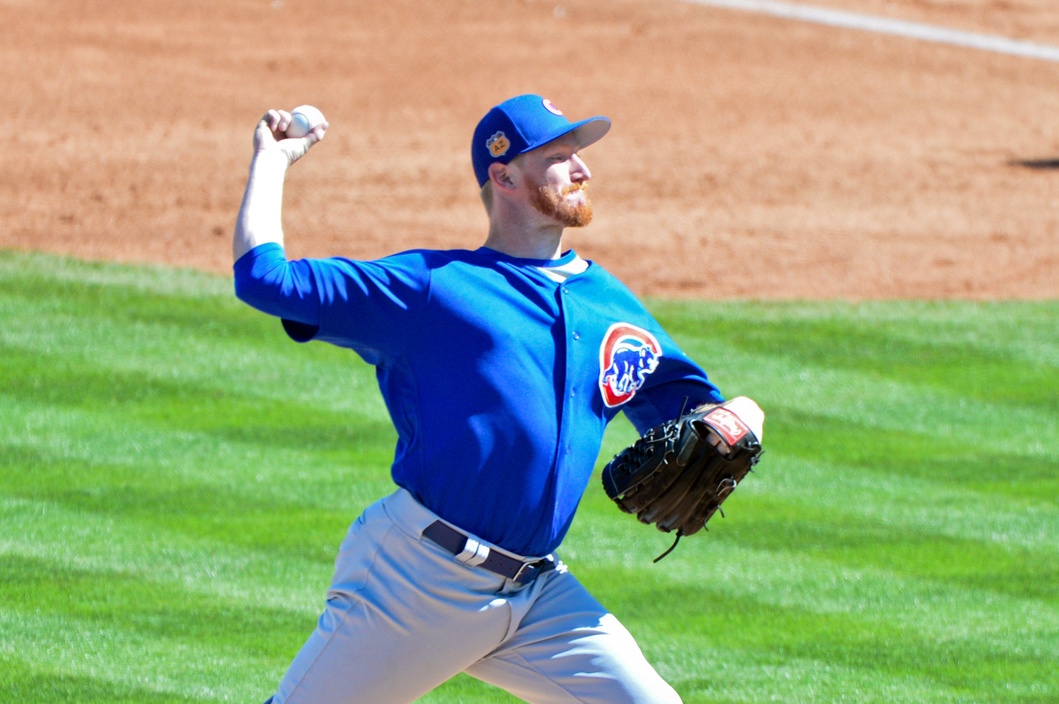Ever since the Chicago Cubs traded for Jake Arrieta and turned him into the bearded wonder that throws no-hitters and wins the Cy Young award, fans have been looking for the next project pitcher to blossom under pitching coach Chris Bosio.
One of the latest is former Colorado Rockie Eddie Butler. After he was designated for assignment, the Cubs pounced, trading international bonus money slot #24 and James Farris for the 25-year-old hurler and the Rockies international bonus money slot #94.
With an option left, Butler will start the season as injury insurance, presumably behind Brett Anderson and Mike Montgomery for the fifth starter spot. His ability to pitch in Iowa gives the Cubs some much-needed flexibility after a couple years of superb rotation health.
So is Butler the Next Big Thing? It looks like he has a chance to be a better pitcher than he was in Colorado because Bosio has familiarity working with a guy who has a similar repertoire: Jake Arrieta.
According to Brooks Baseball, Butler’s primary pitch is a 94 mph sinker, but he also throws a 94 mph four-seam fastball, an 88 mph slider, and, occasionally, an 81 mph curve and an 88 mph changeup.
Arrieta throws a 94 mph sinker while using a 94 mph four-seam fastball, a 90 mph slider, and an 81 mph curve with the rare 89 mph changeup.
In terms of velocity, these are extremely similar primary and secondary pitches. This is all very familiar, but it isn’t apple-to-apples because Arrieta’s “stuff” is superior—his pitches have more movement and generate more swings and misses. The point is not that Eddie Butler is going to win the Cy Young award with the Cubs, or post a sub-two ERA anytime soon, but that Chris Bosio knows how to work with this kind of pitcher.
Butler has started 38 games at the major league level and has thrown 159.1 innings with a 6.50 career ERA and a 117 cFIP, good for -1.7 WARP over that time. While playing in Colorado hasn’t helped Butler, he hasn’t been great away from the high-altitude of Coors Field, either. Butler has thrown in 69.1 innings at home with a 7.92 ERA, 14 home runs allowed, and a 1.962 WHIP. On the road, he’s thrown 90 innings with a 5.40 ERA, and a 1.622 WHIP with 14 home runs allowed.
With a career a .347 BABIP, it’s clear that Butler has been unlucky during his time in the bigs. As a prototypical groundball pitcher (Brooks Baseball calls his curve a “real worm killer”), throwing in front of the Cubs’ elite defense should drastically improve his luck. The Cubs were the best defensive unit in the game last season with a 69 DEF rating and the Rockies were 21st with a -20.4. Even if his pitches don’t improve under Bosio, Butler should be able to enhance his overall numbers by simply being a Cub.
But what can Bosio focus on to get Butler on the right track? Improving his strikeout rate and lowering his walk rate should be the biggest priority. With a career 5.3 SO/9 and a 4.0 BB/9, he just isn’t missing enough bats while allowing too many free passes. According to the 2016 Baseball Prospectus Almanac, his changeup was his “money pitch” as a prospect, but it just wasn’t deceiving anyone at the major league level—Butler had “the seventh-lowest whiff rate and the highest line-drive rate” among pitchers who threw at least 200 changeups during the 2015 season).
It’s something Bosio was able to do with Arrieta compared to his time in Baltimore. During his first three seasons with the Orioles, Jake owned a 6.8 K/9 and a 3.8 BB/9. From 2014-2016 with the Cubs, he increased his strikeout rate to 9.2 and lowered his walk rate to 2.5.
As stated earlier, this is not to say that Butler is going to magically become Jake Arrieta, but there should be a lot of hope that he can become a guy capable of sticking in the rotation as a four or five. With a similar repertoire to Arrieta, Bosio has a rough blueprint for how to help Butler get there. Add in the Cubs defense on top of everything else, and Eddie Butler is definitely a guy to keep an eye on. It would not be surprising to see him take a big step forward when he toes the rubber for the Cubs in 2017.
Lead photo courtesy Matt Kartozian—USA Today Sports
